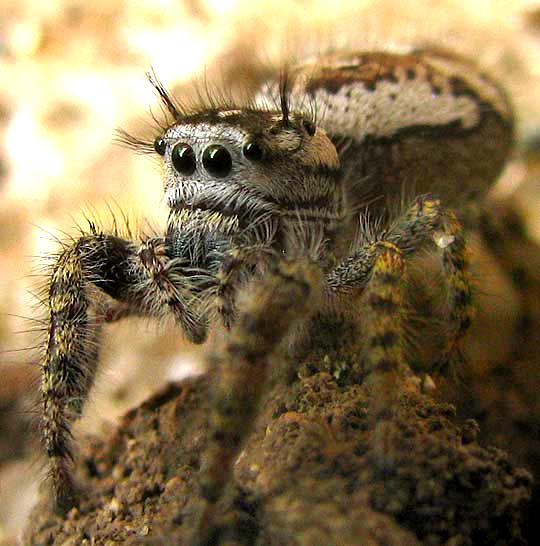Excerpts from Jim Conrad's
Naturalist Newsletter

from the November 17, 2013 Newsletter issued from the Frio Canyon Nature Education Center in the valley of the Dry Frio River in northern Uvalde County, southwestern Texas, on the southern border of the Edwards Plateau; elevation ~1750m (~5750 ft); N29.62°, W99.86°; USA
JUMPING SPIDER
Two fellows were lowering a submersible pump 300 feet down the well recently dug beside Juniper House, and they had stories to tell. What a world of inexplicable events, conspiracies, and hypocrisies we live in! On the side of our 1100 gallon water tank one of the men spotted a dark little spider about the size of a fingernail, and with awe announced that it was the Blister Spider. Blister Spiders spit venom at you causing big blisters all up your arms and on your face, blisters that are surpassingly painful and don't heal well. While describing the horror of the blisters, the man's hands pantomimed venom arcing through the air and descending all over a victim. Once Blister Spider stories were exhausted, talk drifted to a certain black-and-white, very hairy spider around here that if you touch it shocks you with high-voltage jolts of electricity.
People standing around the well may have had doubts about the electricity spider, but that dark little spider on the tank had been identified by someone who knows his spiders, so people stayed well away from it. Except me; I got so close that more than once the spider jumped onto my camera lens, and onto me. Despite the spider's curiosity, I got the great picture shown below:

Atop this page a view from above shows striking patterns on the abdomen and cephalothorax. I didn't notice any spigots for spurting venom onto people, but I didn't look too hard because to me this looked like an ordinary jumping spider. But there are lots of jumping spider species, and eventually I identified it as a female PHIDIPPUS ARIZONENSIS, apparently fairly common in the understory of oak woodlands in arid parts of the southwestern US and adjacent Mexico.
It's true that, in general, jumping spider venom is powerful stuff; often you see them subduing surprisingly large prey. However, they're so small and their mouthparts are so miniscule that they're no problem for humans, plus they show no interest in attacking us -- though if you get as close as my camera lens did, just an inch or two away, they might jump on you, maybe just for fun. Jumping spiders don't produce webs but they do use silk to build cocoon-like retreats for themselves and egg casings, and as they wander about they leave behind silken safety lines.
entry dated June 5, 2023, issued from near Tequisquiapan; elevation about 1,900m, (6200 ft), ~N20.57°, ~W99.89°; Querétaro state, MÉXICO
(~N20.55°, ~W99.89°)
JUMPING SPIDER, A MEXICAN VARIATION

At first glance it's hard to believe that the spider shown above is the same species shown atop this page, but often it's the case that colors come and go, while patterns remain the same. The abdomen of the top one, seen in Texas, is considerably more slender than our Mexican, but females tend to have larger abdomens than males, plus abdomens swell and contract, depending on how much food they've eaten recently.

Our Mexican spider was on a lime-washed courtyard wall in deep shadows behind a home at the edge of a small village not far from hacked-over mesquite thickets and overgrazed ranchland. Insect-attracting lantanas were in full bloom against the wall, and when our spider got nervous, shelter was taken down below them. Jumping spiders engage us with their big, goggle eyes fixed in their forward-directed "faces." The one above is looking up, seeming to beam interest in our direction

Jumping spiders, like other spiders, possess eight eyes. One set peers toward the sides, as seen above.
In Texas as well as this area and uplands between, Phidippus arizonensis is one of the most common jumping spider species. Since it's so common in Texas, you'd think the species would be known by an English name, if only as the Arizona Jumping Spider, from its binomial. However, the species apparently doesn't occur in the US state of Arizona. When G.W. and E.G. Peckham formally named the spider in 1883, the location of the collection they were working with was annotated only as "Arizona," but at that time the boundaries of what was considered Arizona were larger than now. The species is distributed from Texas south into southern Mexico.
Often Phidippus arizonensis is described as inhabiting the understory of oak woodland, and that was right for our Texas spider. However, at this location in upland central Mexico we have no oaks; our spider's home was leaf clutter below ornamental lantanas in someone's walled-in backyard.
Clearly, this is a variable, adaptive species, and as such seems poised to be among the survivors when the current wave of mass extinctions ends.